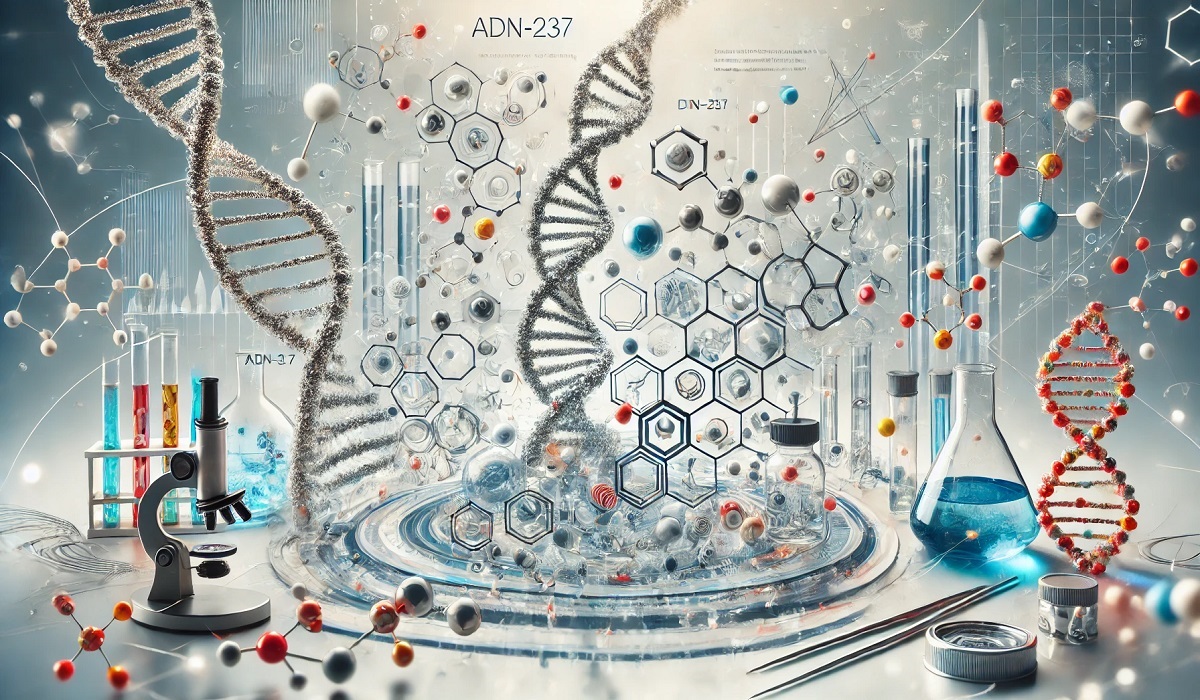GUIDE
ADN-237: Unlocking Potential in Biotechnology and Research

In the ever-evolving world of scientific research and biotechnology, new compounds are constantly being explored for their potential applications in medicine, pharmaceuticals, and beyond. One such compound that has garnered attention in recent years is ADN-237. Although relatively new, ADN-237 is believed to have significant promise in various scientific fields, particularly in biotechnological advancements and drug development.
This article will explore ADN-237 in detail, its possible applications, the scientific background behind it, and why it is an exciting compound for the future of research.
What is ADN-237?
ADN-237 is a chemical compound that falls under the category of molecular structures being studied for its potential therapeutic properties. While ADN-237 is still undergoing research and is not widely used in mainstream medical treatments, it is being studied extensively for its applications in biotechnology, especially in the development of new drugs and therapies.
This compound has intrigued researchers due to its unique molecular structure and its potential to interact with biological systems in ways that can be harnessed for medicinal purposes. Though details on ADN-237 are still being uncovered, initial studies have shown promise in terms of its bioactivity and how it might influence various biological pathways.
The Chemical Structure of ADN-237
Understanding the structure of ADN-237 is crucial to understanding how it works and why it has such potential. ADN-237 consists of a complex arrangement of atoms that allow it to interact with specific receptors in biological systems.
Key Features of ADN-237’s Structure:
- Molecular Bonds: ADN-237 contains several strong molecular bonds that enable it to bind with receptors in cells and tissues, potentially altering biological responses.
- Functional Groups: Its structure includes certain functional groups that make it suitable for interaction with enzymes or proteins involved in disease processes.
- Stability: Preliminary research indicates that ADN-237 may be relatively stable under various conditions, which is essential for its potential therapeutic applications.
The detailed molecular makeup of ADN-237 is a critical area of study, as small alterations in its structure could drastically change how it interacts with biological systems.
Current Applications of ADN-237
Although ADN-237 is still in the experimental stages of research, scientists are exploring a wide range of possible applications in various fields. Some of the most promising areas for ADN-237 include:
1. Drug Development
ADN-237 has shown potential in being a part of the development of new drugs, especially those aimed at combating certain diseases. Researchers are particularly interested in its effects on cellular pathways related to cancer, inflammation, and even neurodegenerative conditions.
- Cancer Research: ADN-237 may target specific cancer cells, helping to stop their growth or even inducing cell death in tumors.
- Anti-Inflammatory Applications: Preliminary findings suggest ADN-237 could play a role in reducing inflammation, which is a key factor in many chronic diseases.
- Neurodegenerative Diseases: Some studies are investigating whether ADN-237 can have a positive effect on the brain, potentially helping in diseases like Alzheimer’s or Parkinson’s.
2. Biotechnology
Beyond drug development, ADN-237’s molecular properties make it a useful compound in biotechnology. This includes applications such as genetic research, enzyme activity modulation, and the development of biotechnology tools.
- Genetic Engineering: ADN-237 may interact with genetic material, possibly influencing gene expression or enhancing gene editing technologies like CRISPR.
- Biomarker Identification: The compound could potentially be used in the identification of biomarkers for disease, helping in diagnostics.
3. Agricultural Applications
Another exciting area of research is ADN-237’s potential in agriculture. There is the possibility that it could be used to develop new types of crops or improve crop yields, particularly in areas related to pest resistance or plant growth.
How ADN-237 Works at the Molecular Level
To truly understand ADN-237’s potential, it’s important to know how it works on a molecular level. The compound interacts with specific biological receptors, which influence various cellular processes. These processes could lead to therapeutic effects when applied in medical or agricultural settings.
Receptor Binding
ADN-237 is thought to work by binding to certain receptors in the body, similar to how other therapeutic compounds work. By binding to these receptors, ADN-237 may alter the activity of cells in ways that can be beneficial for treating diseases.
Cellular Pathways
Once ADN-237 binds to its target receptor, it could initiate changes in cellular signaling pathways. This process is key for modulating biological responses such as immune system activity, gene expression, or even the regulation of cell division and apoptosis (cell death).
Enzyme Interactions
Like many other bioactive compounds, ADN-237 may also interact with enzymes. Enzymes are proteins that catalyze biochemical reactions, and by interacting with specific enzymes, ADN-237 could influence metabolic processes, gene expression, or even the degradation of harmful substances in the body.
Scientific Research on ADN-237
Research into ADN-237 is still in its early stages, and many studies are ongoing to better understand its potential. Most of the current research involves preclinical studies, including lab-based experiments on cell cultures and animal models. These studies are designed to test the safety, efficacy, and stability of ADN-237.
Scientists are particularly focused on:
- Toxicity Studies: Ensuring that ADN-237 does not cause harm to cells, tissues, or organs.
- Pharmacokinetics: Understanding how ADN-237 behaves in the body, including how it is absorbed, distributed, metabolized, and excreted.
- Clinical Trials: While ADN-237 has not yet reached the stage of human trials, researchers are hopeful that it could enter clinical trials in the future once more data on its safety and effectiveness are collected.
The Potential Future of ADN-237
Looking ahead, ADN-237 could have a major impact on various industries, particularly in pharmaceuticals and biotechnology. Its ability to interact with specific biological pathways could pave the way for the development of new treatments for a variety of diseases, including cancers, inflammatory disorders, and neurodegenerative diseases.
Additionally, ADN-237’s applications in biotechnology, genetic engineering, and even agriculture open up exciting possibilities for its future use. However, further research is necessary to unlock the full potential of this compound.
Challenges and Considerations
While the potential of ADN-237 is undeniable, there are still challenges that must be addressed before it can become a widely used tool in medicine or biotechnology. These challenges include:
- Safety: Extensive safety testing will need to be conducted to ensure that ADN-237 does not have harmful side effects.
- Regulatory Approval: As with any new compound, ADN-237 will need to undergo rigorous regulatory approval before it can be used in medical or commercial applications.
- Cost and Production: Manufacturing ADN-237 at a scale suitable for medical or agricultural use may present logistical and cost-related challenges.
Conclusion
In conclusion, ADN-237 is an exciting compound that holds immense potential for future applications in medicine, biotechnology, and agriculture. While much remains to be learned about its full capabilities, early studies suggest it could be a groundbreaking tool in treating diseases, enhancing genetic research, and even improving agricultural practices. As research continues, ADN-237’s role in scientific innovation will likely grow, and its potential applications could make a significant impact across various industries.
FAQs
What is ADN-237 used for?
ADN-237 is currently being researched for its potential applications in drug development, biotechnology, and agriculture, particularly in disease treatment and genetic research.
How does ADN-237 work?
ADN-237 interacts with specific receptors in the body, influencing cellular pathways and enzyme activities that could lead to therapeutic effects.
Is ADN-237 safe?
ADN-237 is still undergoing preclinical research, and its safety has not been fully determined. Toxicity studies and safety trials are ongoing.
What diseases could ADN-237 help treat?
Preliminary research suggests ADN-237 could have potential in treating cancer, inflammatory disorders, and neurodegenerative diseases like Alzheimer’s.
When will ADN-237 be available for use?
It is still in the early stages of research, and more studies will be needed before ADN-237 can be used in clinical settings or commercial applications.
Can ADN-237 be used in agriculture?
Yes, ADN-237 is also being explored for its potential to improve crop yields and provide resistance to pests in agriculture.
What is the future of ADN-237?
ADN-237 could play a significant role in drug development, biotechnology, and agriculture, but further research and testing are required.

 BUSINESS8 months ago
BUSINESS8 months agoService Top: Understanding Role, Dynamics, and Consent in Relationships

 TECHNOLOGY7 months ago
TECHNOLOGY7 months agoSSIS 858: Everything You Need to Know

 GUIDE7 months ago
GUIDE7 months agoLookmovie2.to Legit: A Detailed Review of Safety and Features

 FASHION8 months ago
FASHION8 months agoDIY Tips to Customize Your Orange Prom Dress and Stand Out

 GUIDE7 months ago
GUIDE7 months agoTokybook: Your Gateway to the World of Audiobooks

 TECHNOLOGY7 months ago
TECHNOLOGY7 months agoUnderstanding Libgen: The Ultimate Free Ebook Library

 GUIDE8 months ago
GUIDE8 months agoLeague of Graphs: The Ultimate Guide to League of Legends Stats and Analysis

 GUIDE7 months ago
GUIDE7 months agoLook at All Those Chickens: The Story Behind the Viral Meme
















